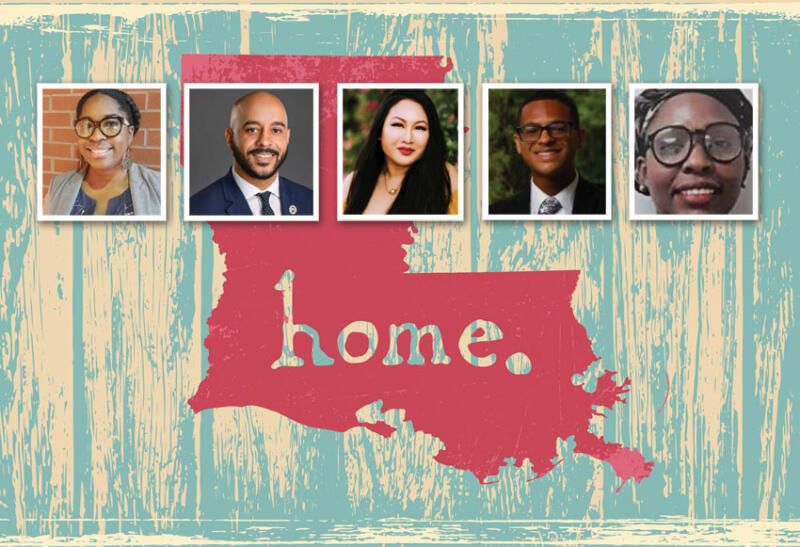Redistricting in Louisiana: The Fight for Fair Maps
(Above, Inset: l-r): Morgan Shannon, Deputy Director, Power Coalition for Equity & Justice; Rep. Royce Duplessis, Louisiana House of Representatives, 93rd District; Jacqueline V. Thanh, Executive Director, VAYLA New Orleans; Carlos Pollard Jr., Redistricting Fellow, Power Coalition/Southern Coalition for Social Justice; and Denise Ramos, Community Organizer, NOLA Garifuna Community Services. (Siliconeer/EMS)
At a briefing co-hosted by Ethnic Media Services; Power Coalition for Equity and Justice, a statewide civic engagement table that works to build power and black and brown communities across Louisiana; and Spotlight PR; a distinguished panel of speakers – Morgan Shannon, Deputy Director, Power Coalition for Equity & Justice; Rep. Royce Duplessis, Louisiana House of Representatives, 93rd District; Jacqueline V. Thanh, Executive Director, VAYLA New Orleans; Carlos Pollard Jr., Redistricting Fellow, Power Coalition/Southern Coalition for Social Justice; and Denise Ramos, Community Organizer, NOLA Garifuna Community Services – discussed redistricting in Louisiana and what that means for communities of color and how to get involved.
Q: Can you explain what redistricting is and why it’s important?
A: Carlos Pollard: Redistricting is the process in which governments redraw political districts and this applies to all levels of government where elections are held. This process only happens every 10 years after the Census data is collected and sent back to the states. Redistricting works by the legislative relying on a few components. These components are Census data experts like demographers and us, public input to draft maps. We play a critical role in this process and our voices and our voice and testimony is very powerful. It’s important to recognize that redistricting sets the foundation for the next 10 years – it plays a critical role in who runs for office; who is elected; and how they vote once they’re in office; and how they represent our communities. Redistricting is one of the factors in determining who represent you and how they represent you.
Q: What redistricting looks like in Louisiana? Why Louisiana is a unique process?
A: Morgan Shannon: Redistricting is essentially putting a puzzle together, a puzzle that is driven by Census data, population loss, population gain, but in going beyond simply looking at the numbers. The maps have to be drawn in a way that communities of interest are able to pick that up; that they’re held together; that these communities are able to pick candidates of choice.
In 2021, for the first time since the passage of the Voting Rights Act, Louisiana is not under the same protection of the pre-clearance requirement that was there in past redistricting sessions. The purpose of road shows is to promote public engagement to give legislators, who will be drawing the maps, an opportunity to hear from communities directly; to give everybody an opportunity to be heard. We should not be making decisions that are going to impact communities without hearing what’s important to those communities.
It’s also important that all of this be on the public record, and that this process be as transparent as possible so that the decisions that are made. We can explain and articulate to communities as to why we made certain decisions, on why districts were drawn certain ways, and impacts that it will have on communities.
When there’s population loss or when there’s population gain, maps have to change.
The state is made up of 40 percent people of color, 33 percent African Americans. Louisiana has six Congressional Representatives, but there is one African American representative throughout the state which equates to only 17 representation at the federal level. Louisiana should have equitable and fair maps that are representative of the state.
Q: What are the implications of redistricting for communities of color?
A: Denise Ramos: Representation is important. Different communities are going to have different interests and we’re not all a monolith, we need to be able to have fair representation in best interests of a particular community.
Q: How do we get to communities who have typically been left behind in this process?
A: Jacqueline V. Thanh: Being intentional about our impact by centering cultural humility is essential in training and outreach strategies. There is a history of exclusion and xenophobia that has happened long before the pandemic but the data gathered and the relationships being built have been foundational, according to the Pew research in April 2021.
Between 2000 and 2019, the Asian American population has nearly doubled, and it’s projected to surpass 46 million by 2060. What that means for Louisiana and New Orleans is meaningful representation is essential for our diaspora. With roots to more than 20 countries in east, southeast Asia, Indian subcontinent, and here in New Orleans we’ve learned through Vietnamese Americans, many survivors of war, refugees, new immigrants, and American-born alike, the power of community, and the power of voting for change, and also building power across communities.
When we say we’re working in solidarity with black and brown communities, it’s less so, we’re showing up because it matters, and it’s wrong. It’s because we are a part of this community. Grace Lee Boggs has always said, “change happens in critical connections, not critical mass.” We build trust by showing up. Political apathy for Asian Americans is a lack of meaningful intentional outreach. Translation services are not optional, but essential right. This is a part of the practice of being American, it’s a part of building, a practice of being Asian American, being able to engage. We’ve been really pushing to connect with the community in ways that are mutual aid centered – how do we bring culturally relevant food; culturally relevant voter engagement; information in a way that is not paternalizing and decenters a lot of what is problematic about history that is not so far behind from us.


